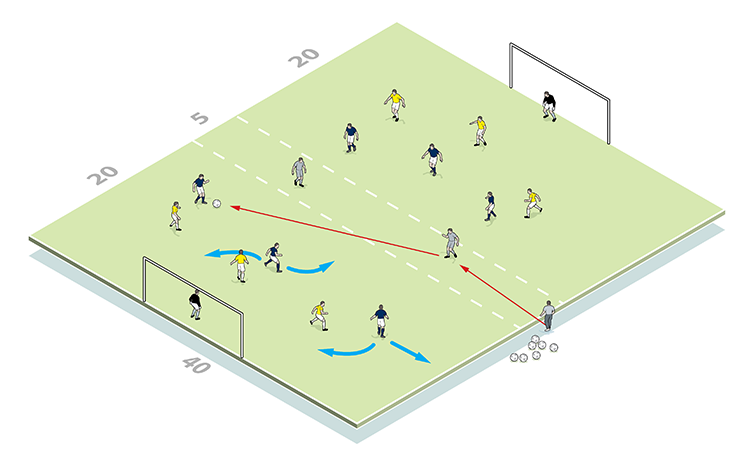




OUR BEST EVER OFFER - SAVE £100/$100
JOIN THE WORLD'S LEADING PROFESSIONAL DEVELOPMENT PROGRAMME
- 12 months membership of Elite Soccer
- Print copy of Elite Player & Coach Development
- Print copy of The Training Ground
You are viewing 1 of your 1 free articles
Improving attacking players in and around the box
This session improves attacking players in key skill areas – namely in pre-movement (dynamic and elusive), penetration (with and without the ball), link-up play, plus the ability to focus on positive outcomes.
| Area | Up to a third of a pitch |
| Equipment | Balls, cones, goals |
| No. of Players | Up to 8v8 |
| Session Time |
Final third practice 15mins, Small-sided game 4x5mins |
This session improves attacking players in key skill areas – namely in pre-movement (dynamic and elusive), penetration (with and without the ball), link-up play, plus the ability to focus on positive outcomes.
It’s important to practise attacking scenarios in and around the box because it refines player knowledge in terms of the positions they need to occupy, gives them confidence to take opportunities that come their way, and also helps with getting the ball in behind the opposition.
We know this works for us – in our final 18 games in the 2012/13 season we saw 22% of our goals being scored from ‘drive and slide’ passes and pre-movements, all elements practised.
What do I get the players to do?
Final third practice
We set up as shown, with four attackers going up against two defenders (1a), who can only press and tackle when one of the two attackers immediately in front of them receives the ball. Defenders and attackers are separated, at first, by a gap of four yards.
1a

The deeper attackers link up and feed the ball in. The attackers nearer the goal are encouraged to move as opposites to one another, creating space in front of the defenders. Once one player has received the ball, one of the deeper attackers can join to create a 3v2 situation in front of goal (1b). However an attack ends, play resets and restarts.
1b

We can progress the practice by adding an extra defender, or by allowing both deeper attackers to join in the attack once the first ball has been played.
What are the key things to look out for?
Players must move before the ball arrives (pre-movement) using dynamic and elusive actions, while ‘drive and slide’ runs mean quick, distinguished and fast passes to team mates on the move. We also want to see good receiving on the back foot, plus combination and link-up play, and a positive goalscoring end product.
Small-sided game
Moving into a game situation, as shown (2a), a 5-yard wide mid-zone represents a free and unopposed area for two neutral midfielders – no other players can enter this area.
2a

Attackers combine with the midfielders to attack each goal (2b). Defenders turning over possession feed the ball into the midfielders, while successful attacks restart with the server.
2b

This time, we progress by allowing midfielders to step in to create 4v3 overloads, particularly if attackers are struggling to create and score. We will also encourage one-touch finishing.
Finally, we’ll remove the mid-zone for an 8v8 that looks to replicate previous outcomes.
Related Files
Editor's Picks
Attacking transitions
Deep runs in the final third
Using the goalkeeper in build-up play
Intensive boxes drill with goals
Penetrating the final third
Creating and finishing
My philosophy
Pressing initiation
Compact team movement
Coaches' Testimonials

Alan Pardew

Arsène Wenger

Brendan Rodgers

Carlos Carvalhal

José Mourinho

Jürgen Klopp

Pep Guardiola

Roy Hodgson

Sir Alex Ferguson

Steven Gerrard
Related
Coaches' Testimonials

Gerald Kearney, Downtown Las Vegas Soccer Club

Paul Butler, Florida, USA

Rick Shields, Springboro, USA

Tony Green, Pierrefonds Titans, Quebec, Canada
Join the world's leading coaches and managers and discover for yourself one of the best kept secrets in coaching. No other training tool on the planet is written or read by the calibre of names you’ll find in Elite Soccer.
In a recent survey 92% of subscribers said Elite Soccer makes them more confident, 89% said it makes them a more effective coach and 91% said it makes them more inspired.
Get Monthly Inspiration
All the latest techniques and approaches
Since 2010 Elite Soccer has given subscribers exclusive insight into the training ground practices of the world’s best coaches. Published in partnership with the League Managers Association we have unparalleled access to the leading lights in the English leagues, as well as a host of international managers.
Elite Soccer exclusively features sessions written by the coaches themselves. There are no observed sessions and no sessions “in the style of”, just first-hand advice delivered direct to you from the coach.







